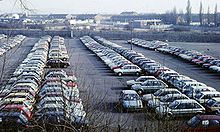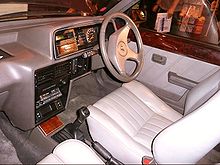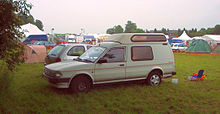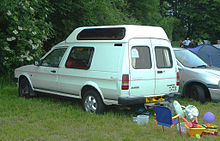- Austin Maestro
-
Austin Maestro Manufacturer Austin Rover Group Also called MG Maestro Production 1983–1994 (Austin Maestro)
1983–1991 (MG Maestro)
1994–2001 (remaining CKD kits, see below)Predecessor Austin Maxi
Austin Allegro
MG 1300Successor Rover 200 Mark II Class compact Body style 2-door van
5-door hatchbackLayout FF layout Engine 1.3 L A-Series I4
1.6 L R-series I4
1.6 L S-series I4
2.0 L O-Series I4
(MG Maestro only)
2.0 L Austin Rover MDi
aka Perkins Prima I4Related Austin Montego Designer Ian Beech
David BacheThe Austin Maestro is a compact-sized 5-door hatchback car (and van derivative) that was produced from 1983 to 1994, initially by the Austin Rover subsidiary of British Leyland (BL), and from 1988 onwards by its successor, Rover Group. The car was produced at the former Morris plant in Cowley, Oxford. It was initially sold as an Austin and a MG. Later models have sometimes been referred to as the Rover Maestro, but the model never wore the Rover badge.
Contents
Background
British Leyland was created in 1975 when the bankrupt British Leyland Motor Corporation was nationalised. In 1977 the South African-born corporate troubleshooter, Sir Michael Edwardes, was recruited as chairman to sort out the troubled firm. Part of Edwardes' plan was to introduce a completely new range of mass-market models to replace the current offerings, designed and built using state-of-the-art technology. The new range eventually decided upon consisted of a new vehicle for each of the small, lower-medium and upper-medium market segments.[1]
Design and development
The new cars for the lower and upper medium segments were to share a platform, with various trim and styling differences to distinguish the two different models. This would give the cost benefits of production automation and flexibility. This common platform was given the project name LC10, using the Leyland Cars project sequence (LC8 became the Austin Mini Metro, LC9 became the Triumph Acclaim). Preliminary design work for LC10 began in 1977.
LC10 was styled by Ian Beech under the direction of BL designer David Bache. Two main body variations were provided: a five-door hatchback and a four-door notchback. It was a departure from previous front-wheel drive cars from the company in that it dispensed with the famous Issigonis transmission-in-sump powertrain that had been pioneered in the Mini. Coupled to the A-Series and R-Series powerplants was an end-on transmission (as pioneered by FIAT with the Autobianchi Primula), purchased from Volkswagen. The sophisticated Hydragas suspension system used on previous BL models was sacrificed on cost grounds, with a conventional MacPherson strut system at the front and a Volkswagen Golf style torsion beam at the rear being used instead, despite the compromise in terms of lost load space. Prototypes were even tested with actual Golf suspension components. This may have led to the Achilles heel of the early cars, which were prone to front-wheel bearing wear/failure. The Maestro was larger and heavier than the first VW Golf.
It was decided that the five-door hatchback version would be engineered first. It was given its own project designation, LM10, with this version to be launched as the Austin Maestro. The booted notchback version was to follow and it was designated as LM11, although its development was to diverge from the original path, it was later launched as the Austin Montego.
Novel features
The Maestro incorporated many novel and pioneering features for its class. It had a bonded laminated windscreen, homofocal headlamps, body-coloured plastic bumpers, an electronic engine management system, a five-speed gearbox on the larger engined models, adjustable front seat belt upper anchorage positions, an asymmetrically split rear seat, and a 12,000-mile (19,300 km) service interval. The MG and Vanden Plas versions had solid-state instrumentation with digital speedometer and vacuum fluorescent analogue displays for tachometer, fuel and temperature gauges, trip computer and a voice synthesis warning and information system.
Reception
The Maestro was launched in March 1983. In its summing up of the new car the Consumers' Association, in the June edition of its Which? journal,[2] described it as roomy, comfortable, and nice to drive, and said "If you are considering buying one now, our advice, based on our first impressions, is to go ahead". In January 1984, after testing the car, they concluded: "In comparison with opposition of a similar price and body size, the Maestro has a clear advantage on room for passengers, with few cars equalling it for comfort either in the front or back". They also considered it to be a serious rival to the higher-segment Vauxhall Cavalier and Ford Sierra, apart from its smaller boot space.[3]
Later developments
The car was a reasonable success, but not as much as beleaguered BL had hoped. After the "boom" years of 1986 and 1987, Maestro sales went into terminal decline. An early reputation for poor build quality and unreliability did not help.[citation needed] The biggest problems centred around the 1.6 litre R-Series engine, which was a hurriedly modified BMC E-Series engine from the Austin Maxi because the under-development S-Series unit was not yet ready for production. R-Series units suffered from hot starting problems and premature crankshaft failure.
The new S-Series engine eventually appeared in July 1984, and was fitted to all existing 1.6-litre Maestros. The new S-Series engine also came fitted with electronic ignition. At the same time, some minor equipment upgrades were made across the range. The 1.3 litre base model gained head restraints, a passenger door mirror and a radio. The 1.3 litre 1.3 HLE, 1.6 litre 1.6 Automatic and 1.6 HLS all gained a radio/cassette player.
In October 1984, there were more equipment upgrades made across the range. The 1.3 base model gained reclining front seats, door bins, locking fuel filler cap and a clock. The L models gained cloth door trim, upgraded upholstery, and a remote-adjustable driver's side door mirror; the 1.6 L gained a 5-speed gearbox. The 1.3 HLE gained a 5-speed "4+E" gearbox with overdrive 5th gear ratio, side mouldings, tweed cloth upholstery and a remotely-adjustable passengers' side door mirror. The HLS and 1.6 Automatic gained tinted glass, central locking, electric front windows, velour upholstery and an upgraded radio/cassette player. The MG Maestro gained an electronic fuel-injected 115 bhp (86 kW) version of the 2-litre O-Series engine, uprated suspension and ventilated front disc brakes, colour-keyed exterior trim, tinted glass, central locking and a leather-trimmed steering wheel.
Also in October 1984, the existing Maestro line-up was joined by the 1.3 HL and 1.6 HL. These models fitted between the L and HLE models.
August 1985 saw the arrival of the 1.3 City and 1.3 City X. The 1.3 City was similar to the previous 1.3 base model. The 1.3 City X added full carpeting, cloth upholstery, head restraints, a rear parcel shelf, a radio and a manually operated choke. These models also did without the plastic bumpers, having more conventional steel bumpers with plastic end caps similar to the Maestro van.
The original dashboard was of a multi-piece construction, and gained a reputation for being flimsy and prone to squeaks and rattles, so in February 1986, this was replaced with the more conventional dashboard from the Montego. At the same time more minor equipment upgrades were made across the range. The City X gained door bins and rear wash/wipe. The L and LE gained tweed trim. The HL and Automatic gained velour trim and additional brightwork. The Vanden Plas gained part leather trim and uprated electronic stereo system.
Following BL's sale to British Aerospace in 1986, Austin badges were dropped in 1987 for the 1988 model year, and the range was sustained by the noisy but economical direct injection naturally aspirated Perkins diesel unit launched the previous year. Unfortunately, without a turbo this model was rather slow.
Following the launch of the new Rover 200 in October 1989, production of the Maestro was pruned back to mostly the entry-level models (with the MG variants being axed during 1991). Production had peaked at more than 101,000 units in 1983, and as late as 1989 nearly 60,000 were made. However, that figure fell to 38,762 in 1990, more than halving the following year to 18,450.
In 1992 the 81 bhp (60 kW) high revving Rover MDi / Perkins Prima turbo diesel unit from the Montego was launched, in the now reduced Maestro range (after the launch of the Rover 200/400), as a Clubman or DLX. The turbo improved refinement, as well as performance, at no cost to fuel economy. It was very competitively priced, it was about the same price as the Rover Metro and Peugeot 205 non-turbo diesel superminis that were a size smaller. The only other engine option was the elderly 1.3 A-series.
In 1993, What Car? buyers' guide section said: "Yes, its old, but nowadays it's also very cheap. Popularity of noisy but economical and surprisingly rapid turbodiesel is what keeps this roomy car going."
Also in 1993, The Automobile Association road tested the Turbo Diesel. Their verdict: "You're hardly likely to buy a Maestro diesel to improve your street cred! For turning heads, the 218/418 diesel is a much better proposition. However, disinterested passengers love the back seat, while the driver can relish the model's marked reluctance to visit filling stations. Here's a hatchback for buyers who are really serious about the substance rather than the image – and with a price tag that's thousands of pounds lower than most of its rivals (shown in our comparison chart), you start saving even before your first forecourt stop. Unless you're averse to gearchanging, this unpretentious Maestro turbo-diesel, at its competitive price, can't seriously be faulted."
In 1993, however, production fell to just over 7,000 units and in its final year, 1994, just over 4,000 were produced, the last one rolling off the production line in December.[4] The chassis development for the Maestro and Montego's rear suspension was used as a basis for later Rover cars, and was well regarded.
In September 1995, production was transferred to Varna, Bulgaria, in complete knock down (CKD) kit form. Around 2,000 vehicles were produced before the company (Rodacar AD) ceased production in April 1996 due to high import costs of the components and little demand for the cars. The majority of the Maestros produced were exported to other countries, including the UK. A small number of these were sold by Apple 2000 Ltd. of Bury St. Edmunds, and registered on an "N" prefix.
In 1997, Parkway Services of Ledbury, Herefordshire, purchased a batch of 621 Maestro cars and vans in CKD kit form. These had been stored at Cowley, Oxfordshire, since their production in mid-1996, when they became surplus to requirements. The company built up the cars and converted the majority of them to RHD form using up Rover's supply of parts. The National Database for Motoring Insurance has records of models registered between "R" and "51" number plates, meaning the overall period of Maestro availability, new in the United Kingdom, was from 1983 to 2001.
The tooling was then sold to First AutoWorks (FAW), China, where the Maestro was available to the Chinese motoring market in both hatchback and van models. A new addition to the range was the FAW Lubao CA6410 – a Maestro hatch with a Montego front end. A handful of Chinese-made parts were imported into Britain whilst these cars were in production, which itself ended in 2005.
MG versions
MG Maestro 1600 (1983–1984)
Rushed into production against engineers' advice at the launch in early 1983, the original MG Maestro was under-developed. Its 1.6 litre R-Series engine ran roughly, was difficult to start when warm, and its Weber twin carburettors could not be tuned by dealership workshops, who were used to SU carburettors. The R-Series model was replaced in July 1984 with the short-lived S-Series model which was built until October 1984 when the EFi was launched. Despite the reliability issues, more than 15,000 MG Maestro 1600s were built.
MG Maestro 2.0 EFi (1984–1991)
After a brief interval, the MG Maestro was relaunched with a fuel injected 2.0 litre engine that gave considerably better performance than its predecessor. Handling and performance were good, and gave Austin Rover its first serious rival for the Golf GTI and Escort XR3i.
This model was trialled as an emergency response/area car by the Metropolitan Police in the early 1990s. However, the Ford Sierra 2.0 litre was eventually chosen as the mainstay of the fleet for reasons of durability and economy.[citation needed]
MG Maestro Turbo (1989–1991)
With the Rover Group only a few months away, the limited edition (500 + 5 press cars) MG Maestro Turbo (launched in early 1989) was the final car from ARG. It made use of the 2.0's already impressive engine, but the combination of carburettor and turbocharger gave it a top speed of almost 130 mph (210 km/h) and an 0–60 mph time of 6.7 seconds. It was faster than the majority of its competitors, but the high performance, Tickford designed bodykit and alloys did little to disguise the fact that it was very much still a Maestro. Sales were slow, as it appeared six years after the Maestro's launch.
Production of the MG Maestro finished in 1991, as Rover was concentrating on the new 200 and 400 models, though the standard Maestro remained in production until December 1994.
Decline and "rebirth"
Production of the Maestro, which was already suffering from a decline in sales, was pruned back by autumn 1989 on the launch of the second generation Rover 200, which was aimed at the higher end of the small family car market, with the Maestro being kept on sale as a cheaper alternative with more basic versions available.
The arrival of the Rover 600 in 1993 saw the closure of the Maestro/Montego assembly line, but small-scale production in complete knock down (CKD) kit form continued until 1994, when BMW's takeover of Rover saw the plug finally being pulled on production almost immediately.
In 1994, Rover established Roadcar, a joint venture with a Bulgarian company to produce Maestros at a new factory in Varna, using CKD kits sent from the UK. Production began in July 1995 and 2,200 cars were assembled before the factory closed in April 1996. The venture failed because of competition from other cars and the Bulgarian government's failure to honour agreements to reduce tariffs on imported parts and buy thousands of Maestros for government departments. [1] Around 1,700 of the Rodacar-made Maestros were exported, including 550 to Uruguay, 400 to Argentina and 200 to the Republic of Macedonia. [2]
Two British dealers, Parkway Services in Ledbury and a company called Apple 2000 in Bury St. Edmunds, acquired unsold Maestros from Bulgaria and sold them in the UK, converting most of them to right-hand drive. [3] Please see the 'Later Developments' above for more information.
The Maestro and Montego tooling were subsequently acquired by Chinese manufacturer Etsong, which introduced a hatchback and a van using Toyota engines. [4] In 2003, the rights passed to First Automobile Works, which introduced a Maestro variant with a Montego front, the Lubao CA 6410, and a van, the Jiefang CA 6440 UA. [5][6] In 2008 the Maestro Van was relaunched as the Yema SQJ6450 by Sichuan Auto Industry Group Company Ltd who had purchased the tooling from FAW.
Reputation
The Maestro sold over 600,000 units thanks to a spacious, practical interior, competitive asking prices, low running costs and good ride and handling, although it failed to match the success of the Ford Escort and Vauxhall Astra. The fact that the company's similarly sized (but upmarket) Honda-based Rover 200 range was one of Britain's strongest sellers during this period serves to highlight the confused development and branding strategies which arguably led to the demise of the company.
A survey by Auto Express magazine, conducted in August 2006, revealed that the Maestro was Britain's ninth most scrapped car of the previous 30 years, with just 11,574 examples still in circulation and in working order in the United Kingdom.
Many Maestros were claimed by rust, corrosion and mechanical problems, although this can be applied to many British cars designed during the same period. Like most pre-1989 Austin Rover cars, 1.3 litre and 1.6 litre Maestros cannot run on unleaded petrol without the cylinder head being converted (re-machining of the cylinder head), or the use of fuel additives. FBHVC (Federation of British Historic Vehicle Clubs) tested and approved lead replacement fuel additives, work out at only a couple of pence a litre. http://fbhvc.co.uk/fuel-information/. The 1994 cc O-series engine in the MG EFi, 2.0i and Turbo has sufficiently hard exhaust valves and seats.
The rear lighting units of the van version lived on until 1998 in the Series I Land Rover Discovery.
Popularity
Despite only going on sale in early March 1983, the Maestro was Britain's sixth best selling car in 1983 with more than 65,000 sales. Its first full year on sale, 1984, brought more than 83,000 sales - which would be the Maestro's best year for sales in any country. As had happened the previous year, it was Britain's best selling car in 1984. However, it had fallen to 10th in 1985; although Austin Rover managed to keep up a strong presence in this sector due to the arrival of the similar sized Rover 200 saloon in August 1984. By 1988, it was merely the 14th best selling car in Britain, dipping further to 19th place in 1989, the year that the second generation Rover 200 was launched. The Maestro was now not only behind the all conquering Ford Escort and Vauxhall Astra (which first outsold it in 1985) in the sales charts, but also behind some foreign competitors including the Volkswagen Golf and Peugeot 309. Sales fell lower still afterwards, as the latest Rover 200 was firmly established as the Rover Group's best seller in this sector, and the Maestro remained on sale as a cheaper alternative until the last ones left the showrooms in the mid 1990s.
Models
Engines
- 1983–1993–1275 cc A-Series I4, 68 hp (51 kW) at 5800 rpm and 75 ft·lbf (102 Nm) at 3500 rpm
- 1983–1985–1275 cc A-Series I4, 64 hp (48 kW) at 5500 rpm and 73 ft·lbf (99 Nm) at 3500 rpm HLE
- 1983 – July 1984–1598 cc R-Series I4, 81 hp (60 kW) at 5500 rpm and 91 lb·ft (123 N·m) at 3500 rpm
- 1983 – July 1984–1598 cc R-Series I4, 103 hp (77 kW) at 6000 rpm and 100 lb·ft (140 N·m) at 4000 rpm MG
- 1984–1993–1598 cc S-Series I4, 85 hp (63 kW) at 5600 rpm and 97 lb·ft (132 N·m) at 3500 rpm
- July 1984 – October 1984–1598 cc S-Series I4, 103 hp (77 kW) at 6000 rpm MG
- 1984–1992–1994 cc O-Series I4, 115 hp (86 kW) MG EFi and 2.0i
- 1988–1990–1994 cc O-Series I4, 152 hp (113 kW) MG Turbo
- 1990–1992–1994 cc Austin/Rover MDi – Perkins Prima NA I4, 62 hp (46 kW)
- 1992–1994–1994 cc Austin/Rover MDi – Perkins Prima TD I4, 81 hp (60 kW) at 4500 rpm and 116 lb·ft (157 N·m) at 2500 rpm
Some prototype versions have a 1.8-litre petrol or Volkswagen's 1.9 diesel engine; these were never used.
Trim levels
The Maestro was available in the following trim levels:
- Base (1983–1985)
- L (1983–1990)
- LE (1986–1988)
- HL (1984–1987)
- HLE (1983–85)
- HLS (1983–1986)
- LX (1990–1993)
- City (1985–1988)
- City X (1985–1988)
- Special (1988–1990)
- Clubman (1990–1994)
- SL (1988–1990)
- Mayfair (1986–1988)
- Vanden Plas (1983–1988)
Chinese production
In 1998, four years after production of the Maestro ended in the UK, the Chinese tobacco company Etsong acquired the tooling and intellectual property rights to the car. In 2000, the company placed it back into production in two variants; the Etsong Lubao QE6400 Ruby and Etsong Lubao QE6440 Laird, built in a brand-new, specially constructed factory in Qingdao, China. The QE6400 used the hatchback bodyshell of the Maestro, but the frontal styling of the Montego, while the QE6440 was a panel van variant. Both cars used Toyota engines and transmissions.
In 2003, Etsong exited the car-making business and sold the Lubao factory to First Automobile Works, one of China's biggest car-makers. FAW discontinued the QE6440 van, but as of 2007 continues to market the hatchback as the FAW Lubao CA6410.
References
- Timothy Whisler (1999). The British Motor Industry, 1945–94: A Case Study in Industrial Decline. Oxford: Oxford Univ. Press. ISBN 0-19-829074-8.
- Adams, Keith. "The Unofficial Austin Rover Web Resource". http://www.austin-rover.co.uk.
Notes
- ^ Timothy Whisler (1999). The British Motor Industry, 1945–94: A Case Study in Industrial Decline. Oxford: Oxford Univ. Press. ISBN 0-19-829074-8.
- ^ "First Impressions: Austin Maestro". Which?: back page. June 1983.
- ^ "Austin Maestro". Which?: 44–46. January 1984.
- ^ http://www.maestro.org.uk/maestro/
External links
Type 1980s 1990s 2000s 2010s 0 1 2 3 4 5 6 7 8 9 0 1 2 3 4 5 6 7 8 9 0 1 2 3 4 5 6 7 8 9 0 1 Ownership BL plc / Rover Group British Aerospace BMW Phoenix Venture Holdings Nanjing Auto / SAIC Group name BL Cars Austin Rover Group / Land Rover Group Rover Group MG Rover NAC MG / MG Motor City car Mini Supermini Austin Metro Rover Metro Rover 100 CityRover MG 3 Small family car Austin Allegro Austin Maestro MG ZR MG 3SW Triumph Acclaim Rover 200 (SD3) Rover 200 (R8) Rover 200 (R3) Rover 25 Large family car Morris Ital Austin Montego MG ZS Rover 400 (R8) Rover 400 (HH-R) Rover 45 MG 6 Princess Austin Ambassador Rover 600 MG ZT Rover 75 MG 7 Executive car Rover SD1 Rover 800 (XX) Rover 800 (R17) Coupé Rover 200 Coupé Sports car Triumph TR7 MG RV8 MG F MG TF MG TF MG SV Off-road and SUV Land Rover SIII Land Rover 90/110 Land Rover Defender (Land Rover acquired by Ford in 2000) Range Rover Land Rover Discovery Land Rover Freelander Automobiles made by BMC, BL and Rover Group companies, post-1945 Austin · Austin-Healey · British Leyland · Jaguar · Land Rover · Leyland · Mini · MG · Morris · Princess · Riley · Rover · MG Rover · Triumph · Vanden Plas · WolseleyAustin A40 · Cambridge · Westminster · A35 · Seven · Mini · Mini Moke · 1100 / 1300 · 1800 / 2200 · 3-Litre · Maxi · Allegro · Ambassador · Mini Metro · Maestro · Montego · Lancer · Freeway · Tasman · KimberleyAustin-Healey Jaguar Land Rover Leyland MG Mini Morris Princess Riley Rover Triumph Vanden Plas Wolseley Categories:- Austin vehicles
- British Leyland vehicles
- Front wheel drive vehicles
- Compact cars
- Hatchbacks
- 1980s automobiles
- 1990s automobiles
- Vehicles introduced in 1983
Wikimedia Foundation. 2010.






